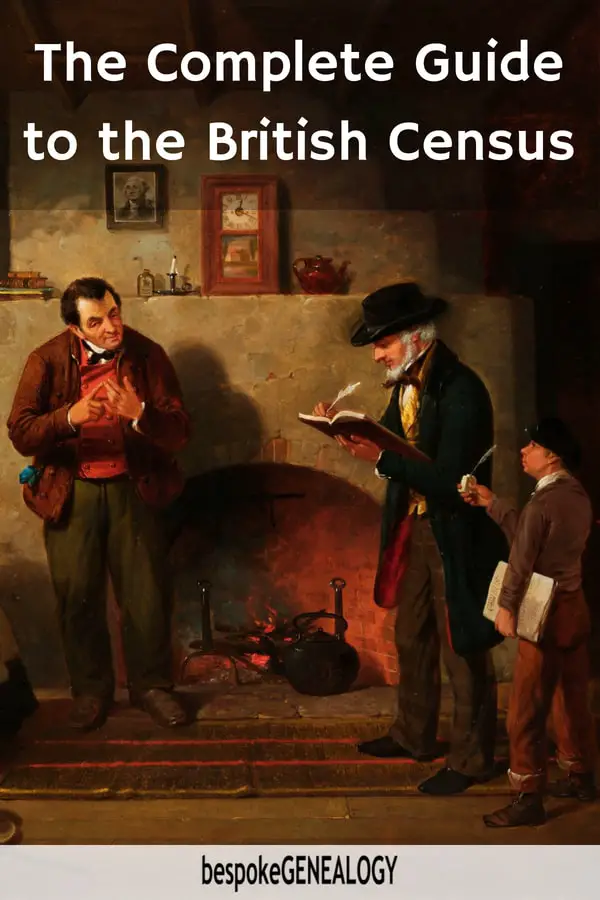
This is another article looking at a major British genealogy record set. Others in the series include; parish registers, civil registration, electoral registers and the Gazettes. This time, the focus is on the British census; what information can be culled from it, which records are missing, where they can be found and what’s available for free.
After vital records, censuses are probably the most important and useful records available to the genealogist. The good news is that in Britain at least (unlike in Ireland), the majority of them survive in some form (with the exception of the England & Wales 1931 census).
This article looks at the British census; I previously covered the Irish census (North and South) in a separate post. The British census covers England, Wales, Scotland, the Channel Islands and the Isle of Man. The format for the census throughout Britain remained the same until 1851. From 1861 there was some divergence with the Scottish return asking some slightly different questions, so I’ll look at both formats. For the purposes of this post, the England and Wales census includes the Channel Islands and the Isle of Man.
I’ll start with where to find British census records online; what’s available for free and what can only be accessed via subscription or pay per view sites. I’ll then give some background to the modern British census and run through all of the censuses, year by year highlighting what information is on them as well as which records might be missing.
Which British census records are available online for free?
Family Search has an index and transcriptions of English and Welsh censuses between 1841 and 1911. It does not have free images of these returns. It also has an index and partial transcriptions of the 1841-1901 Scottish censuses.
FreeCEN has an index and transcriptions of a percentage of English & Welsh censuses between 1841 and 1891 and Scottish censuses between 1841 and 1871. Check their website to see which counties and parishes are available.
Which British census records are held by the pay sites?
FindMyPast holds:
- Index, transcriptions and images of all the English & Welsh censuses between 1841 and 1921.
- Index and transcriptions only of the Scottish censuses between 1841 and 1901.
- Index, transcriptions and images of the English & Welsh 1939 Register
The Genealogist holds:
- Index, transcriptions and images of all the English & Welsh censuses between 1841 and 1911.
- Index and transcriptions only of the Scottish censuses between 1841 and 1901.
- Index and transcriptions of the English & Welsh 1939 Register
Ancestry holds:
- Index, transcriptions and images of all the English & Welsh censuses between 1841 and 1911.
- Index and transcriptions only of the Scottish censuses between 1841 and 1901.
- Index, transcription and images of the English & Welsh 1939 Register
Scotland’s People holds:
- Index and images of all the Scottish censuses between 1841 and 1921.
Background to the modern British Census
The first census in England was William the Conqueror’s Domesday Book in 1086. Between then and the start of the nineteenth century there had been various other censuses carried out, often undertaken by the Church.
At the end of the eighteenth century, there had been concern about population growth and the demand for food. This led to the Census Act of 1800 and the first modern national census in Britain taking place in 1801. Since then there have been further censuses every 10 years (apart from in 1941).
The first four censuses; 1801-1831 were just used for statistical reports so they do not contain much useful genealogical information, although there is some as I explain below.
The General Register Office (GRO) in London had been created in 1836 to oversee the civil registration of births, marriages and deaths. The GRO also took on responsibility for the census in England and Wales from 1841 onwards. Civil registration didn’t begin in Scotland until 1855, so the GRO was responsible for the census in Scotland until 1851.
Individuals were listed in all cases from the 1841 census onwards. Households were given blank schedules to complete and these were then collected by the enumerator and transcribed into census enumerator’s books (CEBs). Unfortunately the household schedules were routinely destroyed. However, the CEBs were kept and it is these transcriptions that survive (in most part) and are available to the family historian.
Transcription errors are fairly common with these records, especially with the earlier censuses so it is advisable to view the original CEB page where possible.
The 1911 England and Wales census is the first one where the household schedules have survived and it is these that are available online.
The UK observes a 100 year privacy rule for census records. Therefore the 1921 census is currently the most recent one that can be accessed. The 1939 Register is available however and is an exception as it is not strictly a census. There is more on the 1939 Register below.
If you are interested in reading more about the history of the British census, I recommend this fascinating book by Emma Jolly:
Tracing your ancestors using the census

1801, 1811, 1821 and 1831 Censuses
For the first four censuses, the Government was only interested in the numbers; numbers of families, houses, individuals, occupations, marriages, christenings and burials.
In England and Wales, the census enumerators were the overseers of the poor as well as some clergy and property owners. In Scotland, it was usually the local schoolmaster who did the enumerating along with some other “educated” men.
The Government was only interested in raw numbers for statistical purposes, however many enumerators found it easier to compile lists of individuals within households first, in order to compile the data required. Many of these lists survive and, where they do, they will probably be held by local county archives.
A useful guide to these surviving listings for England can be downloaded from the University of Essex website here. The guide lists what is known to have survived by county and parish or township and where the original documents or transcriptions are held. As the authors note in the introduction though, the list is not complete as new records periodically surface.
If you are looking for Scottish records, then getting hold of Census Records for Scottish Families at Home and Abroad by Gordon Johnson should help you find which parishes have surviving listings. This book is out of print, but you may be able to get hold of a copy via your local library or buy a used one on Amazon.
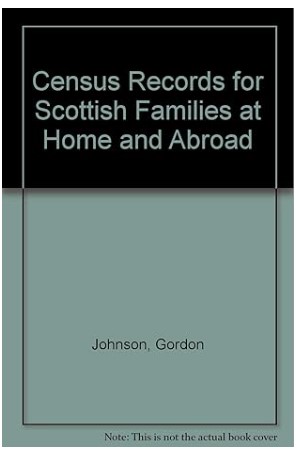
Click here to see it on Amazon
Another out of print book covering listings throughout the UK is Local Census Listings 1522-1930 by Gibson and Medlycott. Again, you may be able to get a copy via your library or find a used copy on Amazon.
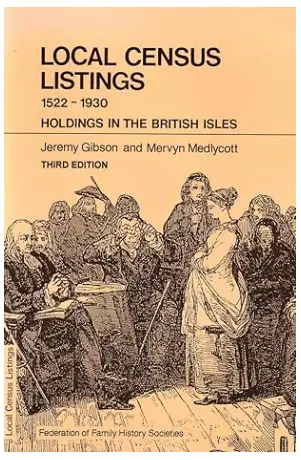
Click here to see it on Amazon
If you find that a listing is available in a parish that you are interested in, the best bet to then contact the local Family History Society for the relevant county. They may have a transcription available to download for free or to purchase. You can find links to these societies and archives in my directory pages for England, Wales and Scotland.
Even if you can’t find a listing in one of the publications mentioned, it’s probably still worth contacting the local FHS or archive, just in case they have one that hasn’t been cataloged.
1841 Census
The first census of real value to the genealogist took place on 6 June 1841. Heads of households were required to fill out the following fields on their schedules:
- Place (usually just the road or village)
- Names of each person who abode therein the preceding night
- Age and sex
- Profession, trade, employment or of independent means
- Where born; whether born in same county (yes or no) or whether born in Scotland, Ireland or foreign parts
Problems with the 1841 census:
- It’s great to have all individuals listed for the first time, but the relationship of the other residents to the head is not shown.
- Place of birth is not very detailed
- Full address is not given
- Enumerators were instructed to round ages of residents over the age of 15 to the nearest 5. Some ignored this and recorded the correct age.
- Some enumerators were confused as to whether or not they should include people who normally resided in a house but were absent on census night. This led to some double counting and some people being missed completely.
- Some records have been lost from
- Cheshire
- Derbyshire
- Southampton
- Kent
- Middlesex
- Northamptonshire
- Oxfordshire
- Somerset
- Surrey
- Wiltshire
- Yorkshire
- Breconshire
- Denbighshire
- Flintshire
- Glamorganshire
- Ayreshire
- Fife
To find the parishes that are missing in these counties see the list on FindMyPast here.
See above on how to access the 1841 census online.
1851 Census
This census was held on 30 March. The heads of households completed the following on their schedules:
- Name of street, place or road and name or number of house
- Relation to head of family
- Condition (marital status)
- Age of males and females
- Rank, profession or occupation
- Where born
- Whether blind or deaf and dumb
Problems with the 1851 census
- As with the 1841 census, some people were recorded twice and others not at all
- Many Royal Navy records have not survived
- Some records from the following counties have been lost:
- Cambridgeshire
- Suffolk
- Essex
- Dorset
- Yorkshire
- Lancashire
To find the parishes that are missing in these counties see the list on FindMyPast here.
See above on how to access the 1851 census online.
1861 Census
The 1861 census was the first where Scotland was responsible for its own survey. Civil registration had been introduced here in 1855 and the General Register Office for Scotland (GROS) established. From this census onwards, the GROS was responsible for the census in Scotland until it was merged with the National Archives of Scotland in 2011 to form the National Records of Scotland.
The census took place on 7 April 1861.
For England and Wales, the head of household in was asked to complete the following:
- Name and Surname of household members. There was a note to not include anyone who was normally resident but was absent on census night.
- Relation to head of family
- Condition (marital status)
- Whether male or female
- Age (last birthday)
- Rank, profession or occupation
- Where born
- If deaf-and-dumb or blind
A separate schedule was designed for ships of the Royal Navy and asked:
- Name and Surname (of everyone on board)
- Rank or quality (if not belonging to ship, state whether a passenger or visitor)
- Condition (marital status)
- Age (and whether male or female)
- Where born
The Scottish schedule asked the same questions as the English & Welsh form but with two additional fields:
- Number of children from 5 to 13 attending school or being educated at home
- Rooms with one or more windows
Problems with the 1861 census:
- There were teething problems with Scotland’s first self administered census; some enumerators were confused as to what was required as answers to questions which resulted in incomplete or incorrect returns.
- Around 3% of records have been lost. Counties affected are:
- Middlesex
- Kent
- Sussex
- Hampshire
- Berkshire
- Hertfordshire
- Buckinghamshire
- Oxfordshire
- Northamptonshire
- Cambridgeshire
- Essex
- Norfolk
- Staffordshire
- Warwickshire
- Leicestershire
- Lincolnshire
- Cheshire
- Yorkshire
- Durham
- Northumberland
- Cumberland
- Monmouthshire
- Glamorganshire
- Carmarthenshire
- Pembrookshire
- Cardiganshire
- Brecknockshire
- Radnorshire
- Montgomeryshire
- Flintshire
- Denbighshire
- Merionshire
- Carnavonshire
- Channel Islands
To find the parishes that are missing in these counties see the list on FindMyPast here.
See above on how to access the 1861 census online.
1871 Census
The census took place on 2 April. Questions asked in England and Wales were similar to 1861 with a bit more information required on disabilities:
- Name and Surname of household members.
- Relation to head of household
- Condition (marital status)
- Whether male or female
- Age (last birthday)
- Rank, profession or occupation
- Where born
- If deaf-and-dumb or blind, imbecile or idiot
The Scottish schedule asked:
- Name and Surname of household members.
- Relation to head of household
- Condition (marital status)
- Age (and whether male or female)
- Rank, profession or occupation
- Where born
- If Number of children from 5 to 13 attending school or being educated at home
- Rooms with one or more windows
- Deaf-and-dumb or blind, imbecile or idiot
Problems with the 1871 census:
- Some records have been lost affecting the following counties:
- Leicestershire
- Lancashire
- Yorkshire
- Glamorgan
- Breconshire
To find the parishes that are missing in these counties see the list on FindMyPast here.
See above on how to access the 1871 census online.
1881 Census
The 1881 census was undertaken on 3 April. The questions asked in the English and Welsh census remained the same as in 1871:
- Name and Surname of household members.
- Relation to head of household
- Condition (marital status)
- Age and whether male or female
- Rank, profession or occupation
- Where born
- If deaf-and-dumb, blind, imbecile, idiot or lunatic.
The Scottish schedule also remained the same as in 1871:
- Name and Surname of household members.
- Relation to head of household
- Condition (marital status)
- Age (and whether male or female)
- Rank, profession or occupation
- Where born
- If Number of children from 5 to 13 attending school or being educated at home
- Rooms with one or more windows
- Deaf-and-dumb, blind, imbecile, idiot or lunatic
Problems with the 1881 census:
- The record set is complete with just a few missing records in Camberwell, London
See above on how to access the 1881 census online.
1891 Census
5 April 1891 was the date for this census. Questions asked on the English and Welsh census included two new questions (number of rooms and whether employer or employed):
- Number of rooms occupied if less than five
- Name and Surname of household members.
- Relation to head of household
- Condition (marital status)
- Age and whether male or female
- Profession or occupation
- Employer or Employed
- Neither Employer or Employed
- Where born
- If deaf-and-dumb, blind, imbecile, idiot or lunatic.
- Language spoken (in Wales)
The Scottish census also had additional questions:
- Name and Surname of household members.
- Relation to head of household
- Condition (marital status)
- Age and whether male or female
- Profession or occupation
- Employer or Employed
- Neither Employer or Employed but working on own account
- Where born
- Gaelic or G&E (whether Gaelic spoken or both Gaelic and English)
- If deaf-and-dumb, blind, imbecile, idiot or lunatic.
- Rooms with one or more windows
Problems with the 1891 census:
- According to FindMyPast, the only known missing records for this census are from Great White Lion Street, London.
See above on how to access the 1891 census online.
1901 Census
The first census of the twentieth century took place on 31 March. The English and Welsh census asked the same questions as 1891, but with a couple of slight amendments:
- Number of rooms occupied if less than five
- Name and Surname of household members.
- Relation to head of household
- Condition (marital status)
- Age and whether male or female
- Profession or occupation
- Employer, worker or own account
- If working at home
- Where born
- If deaf-and-dumb, blind, lunatic, imbecile or feeble minded
Likewise the Scottish census also remained broadly the same:
- Name and Surname of household members.
- Relation to head of household
- Condition (marital status)
- Age and whether male or female
- Profession or occupation
- Employer, worker or on own account
- If working at home
- Where born
- Gaelic or G&E (whether Gaelic spoken or both Gaelic and English)
- If deaf-and-dumb, blind, lunatic, imbecile or feeble minded.
- Rooms with one or more windows
Problems with the 1901 census:
- FindMyPast report that the only known missing records from this census are the returns from Deal in Kent which are missing in their entirety.
See above on how to access the 1901 census online.
1911 Census
The 1911 census was held on 2 April. The household schedules for England and Wales have survived, so we can see our ancestors’ handwriting on these forms for the first time. Unfortunately in Scotland the household schedules were destroyed, leaving only the enumerator’s schedules.
New questions were added to both the English & Welsh and Scottish censuses. The full lists of questions are:
England & Wales:
- Name and Surname of household members.
- Relation to head of family
- Age and whether male or female
- Particulars as to Marriage (marital status)
- Plus years in marriage for married women
- Children born alive to present marriage
- Children still living
- Children who have died
- Profession or occupation
- Birthplace
- Nationality
- Infirmity (If deaf-and-dumb, blind, lunatic, imbecile or feeble minded)
- Number of rooms
Scotland:
- Rooms with one or more windows
- Name and Surname of household members.
- Number of persons in house
- Relation to head of family
- Age and whether male or female
- Gaelic or G&E (whether Gaelic spoken or both Gaelic and English)
- Particulars as to Marriage (marital status)
- Plus years in marriage for married women
- Children born alive to present marriage
- Children still living
- Children who have died
- Profession or occupation
- Birthplace
- Nationality, if born in a foreign country
- If deaf-and-dumb, blind, lunatic, imbecile or feeble minded.
Problems with the 1911 census:
- FindMyPast reports that there are no missing records with this census.
See above on how to access the 1911 census.
1921 Census
The 1921 census was held on 19 June of that year. The English and Welsh census is available exclusively on Findmypast. The Scottish census can be accessed on a pay per view basis on Scotland’s People.
As with the 1911 census, the household schedules for England and Wales have survived, so we can see our ancestors’ handwriting on these forms.
The most exciting aspect of this census is that employers names and addresses are recorded for the first time. This means that you can pinpoint exactly where your relatives were working. For example, I’ve just discovered that one of my relatives was working at the Cammell Laird Shipyard on Merseyside.
The full lists of questions on the 1921 English and Welsh census (new questions in bold):
- Name and Surname of household members.
- Relation to head of family
- Age in years and months
- Whether male or female
- Whether married or orphaned (for children). 1921 was not long after the end of the First World War and the Spanish flu epidemic, so there were many more orphaned children than in previous census years.
- Birthplace and Nationality
- Education – part-time or whole-time
- Personal occupation
- Name and address of employer
- Number and ages of living children under the age of 16
1931 Census
Sadly the 1931 English & Welsh census records were destroyed after a bombing raid during the Second World War in 1941. The Scottish records survive and will be released in 2031 unless there is a change in the law.
1939 Register
Although not strictly a census, the 1939 Register is very census like. It was undertaken on the eve of the Second World War so that the Government could determine who was available for the armed services and other war work and also to issue identity cards. It was held on 29 September.
After the war, it became the basis for administering the new National Health Service and was kept up to date until computerization in the 1980s.
Although the Register doesn’t show the relationships to the head of household and places of birth, it is still very useful to genealogists as it shows dates of birth. Also as the Registers were still being used for many years after the war, they were often amended; so names of single women were crossed out and replaced with their married names at later dates.
The questions asked were:
- Address
- Surname and other names
- Male or female
- Date of Birth
- Marital status
- Personal occupation
The Register for England & Wales can be accessed online (see below). However, details of anyone under the age of 100 have been blacked out unless their death has been confirmed.
The Scottish Register is not available online and can only be viewed by visiting the National Records of Scotland in Edinburgh.
The 1941 census did not take place due to the war, and as the 1931 census was lost, the 1939 register is the closest thing available to a census in England & Wales between 1921 and 1951.
See above on how to access the 1939 Register.
For more on the 1939 Register see: Preparing for War: The 1939 Register
Happy researching!
For further reading, you may find these genealogy books of interest:
There are more genealogy books in the Resources section.
Please pin a pin to Pinterest:

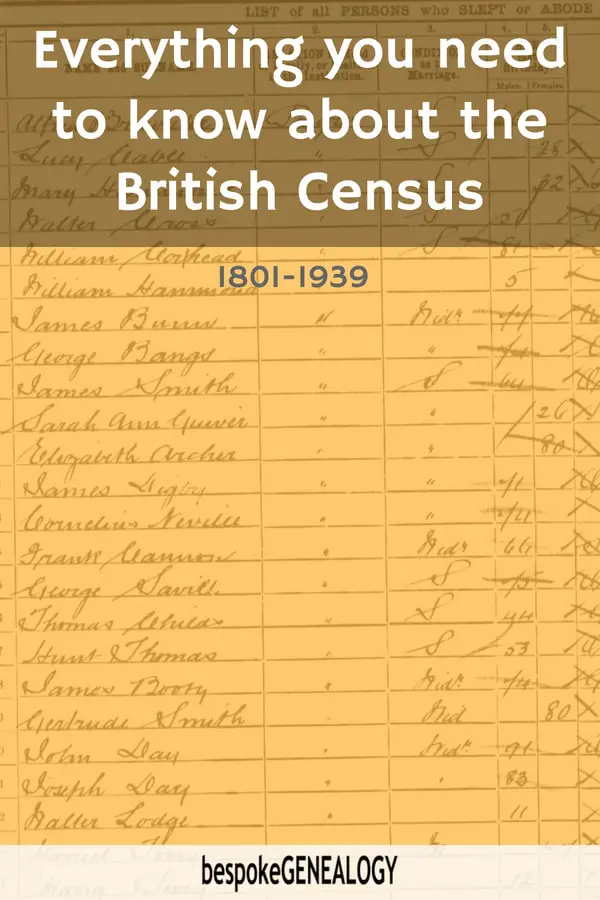
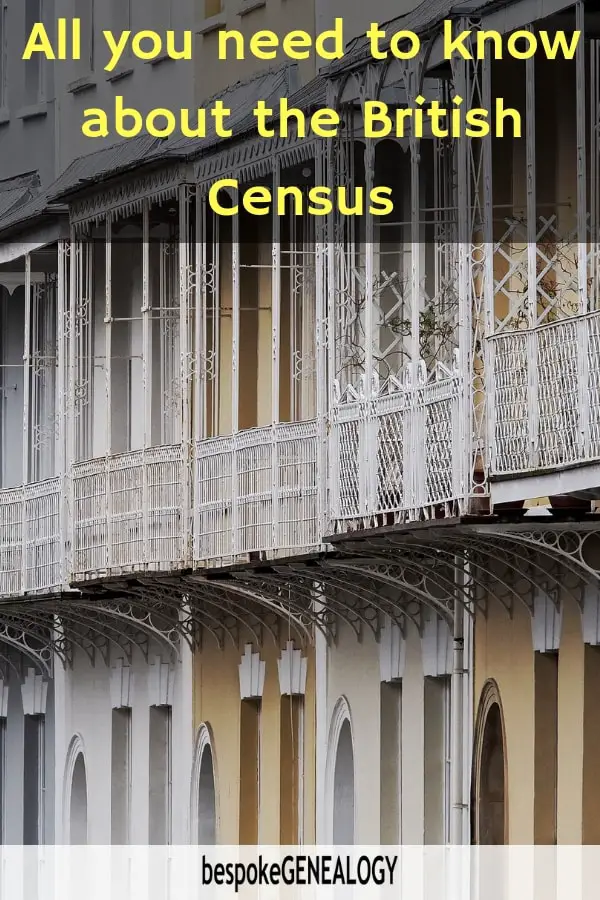
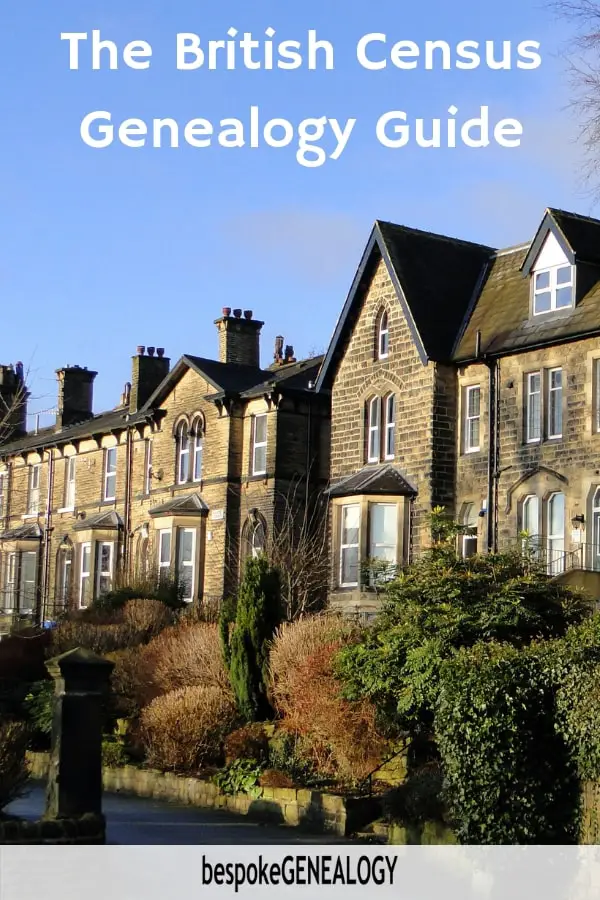
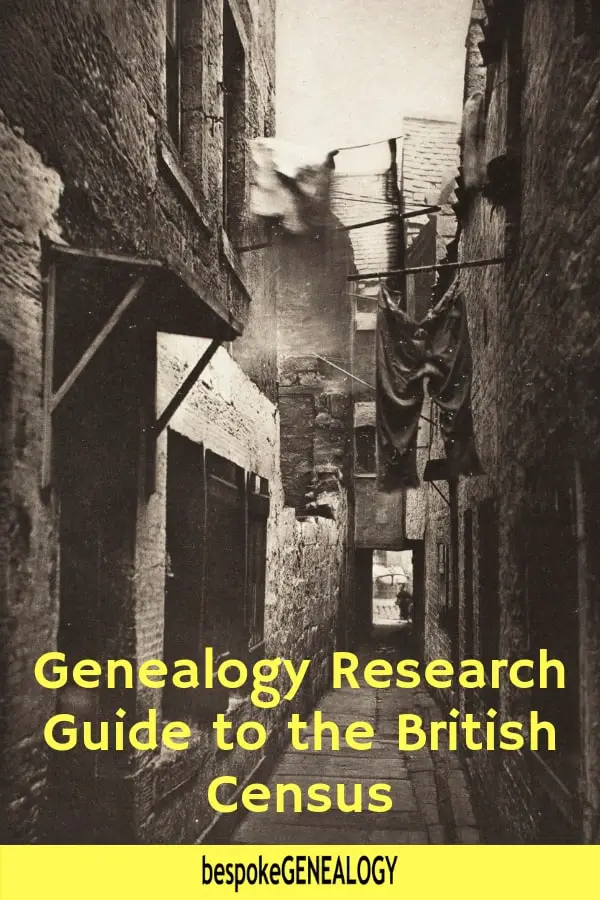

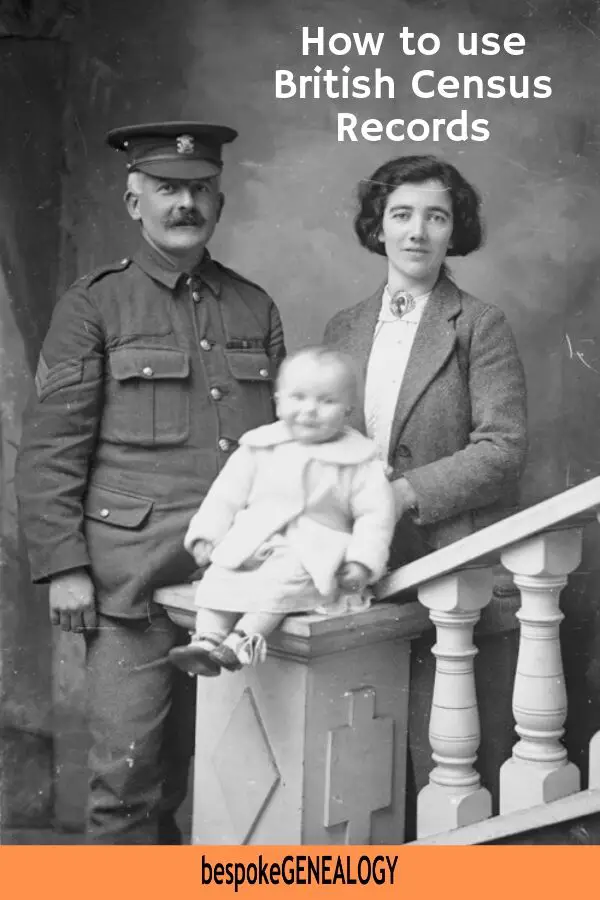
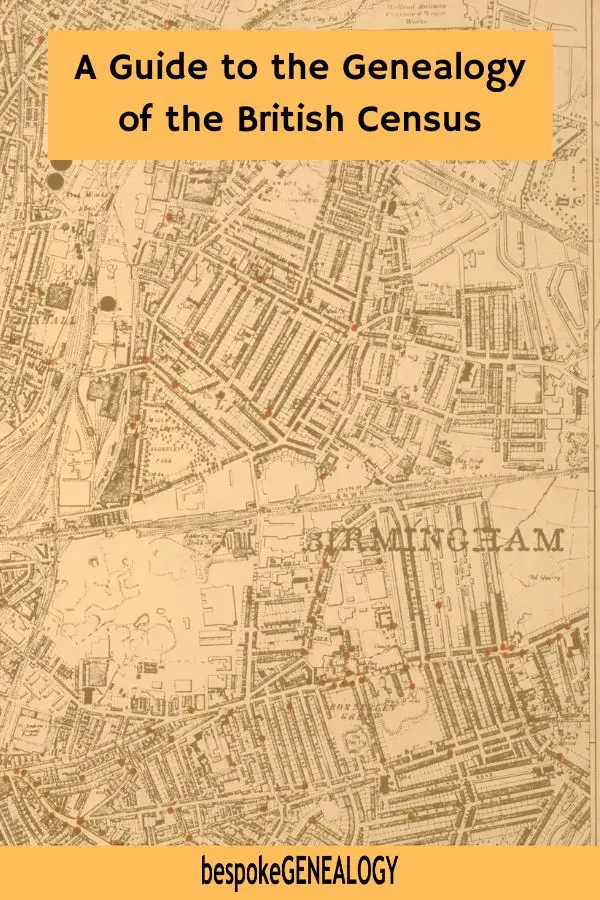
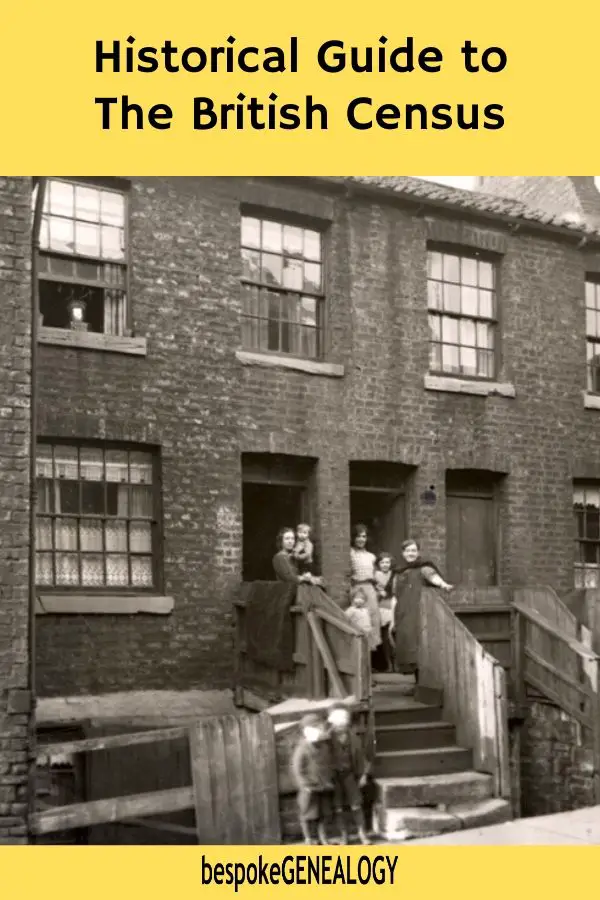
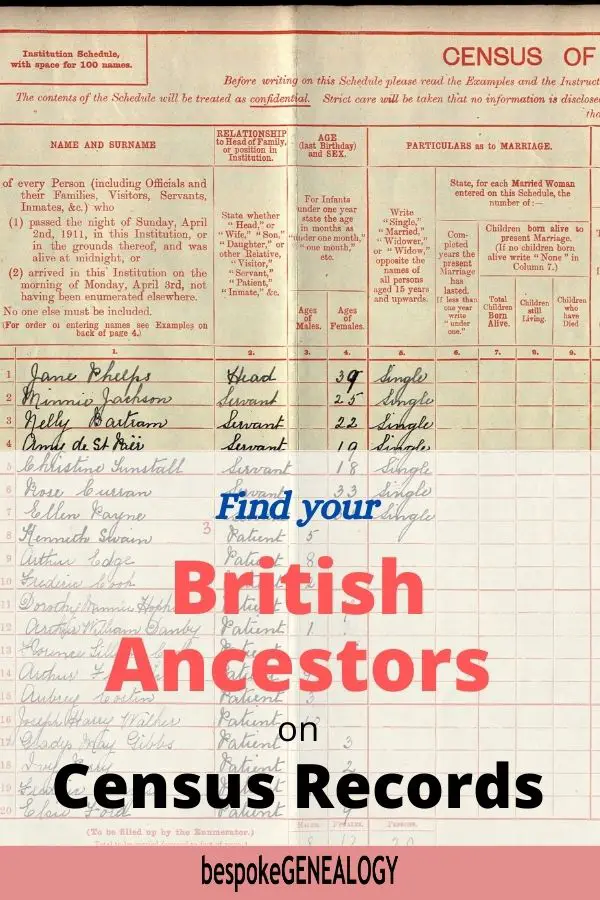
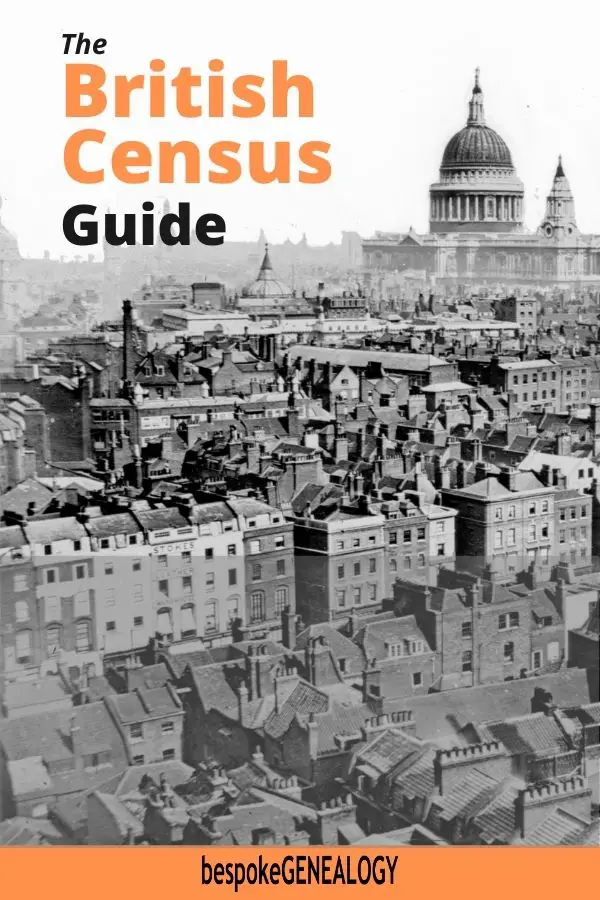
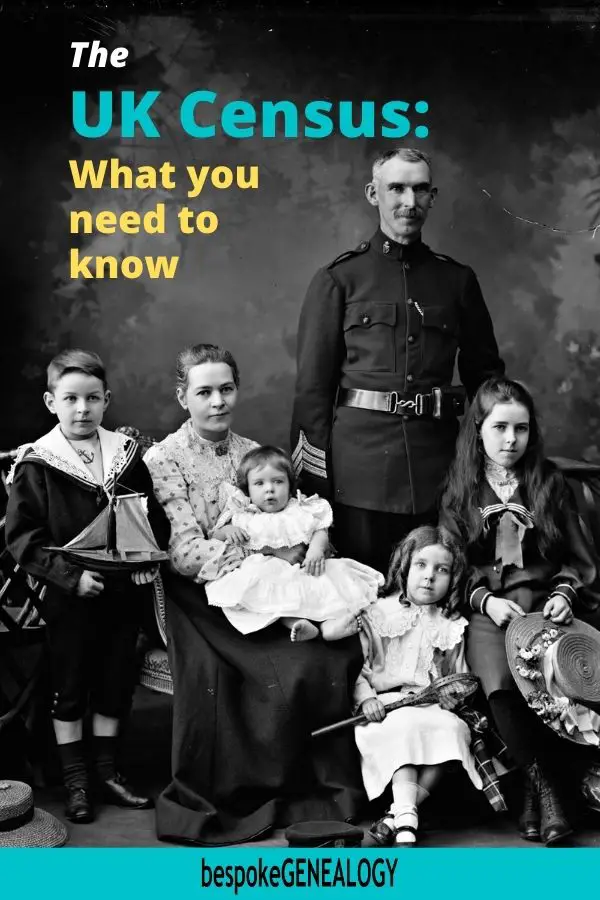


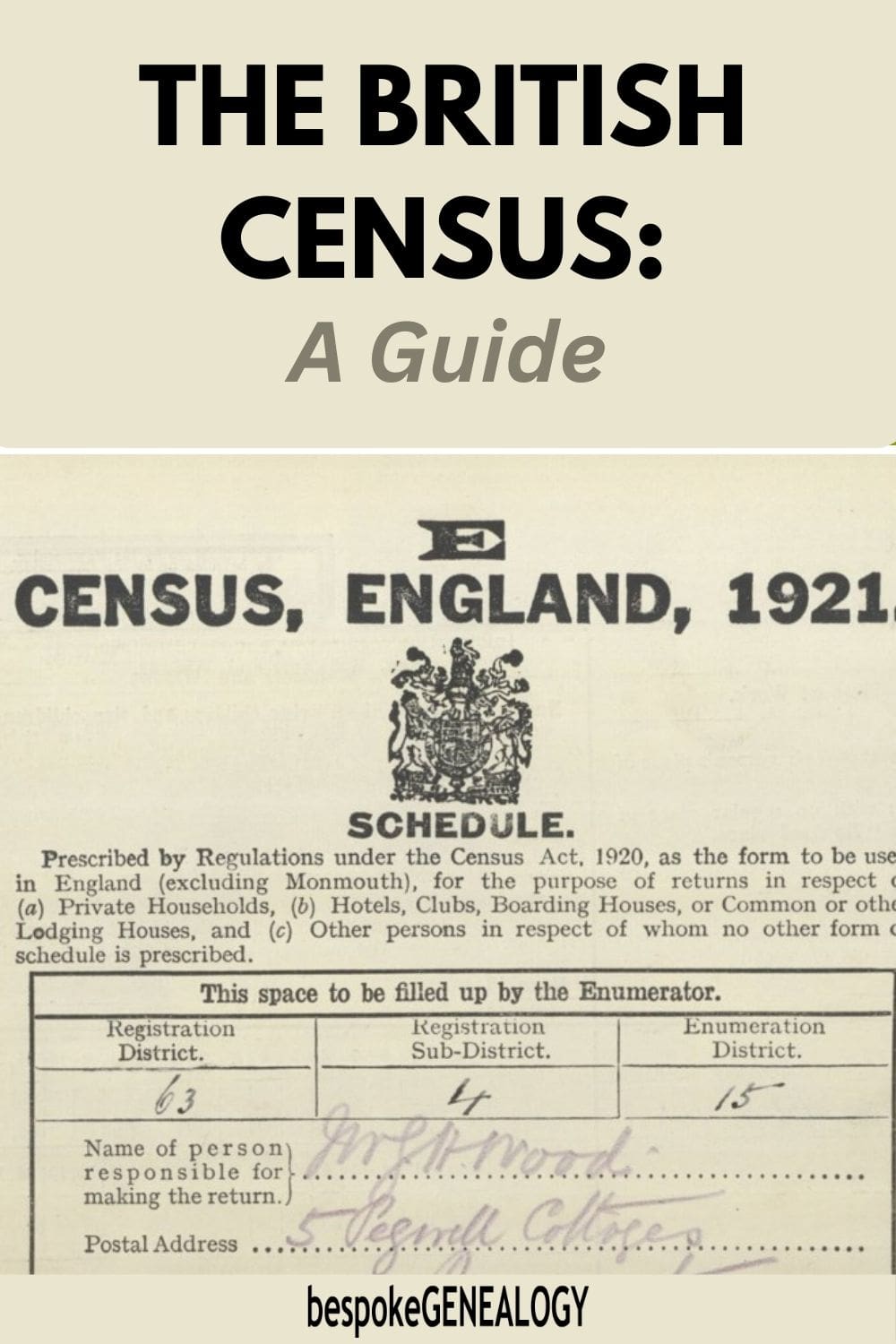


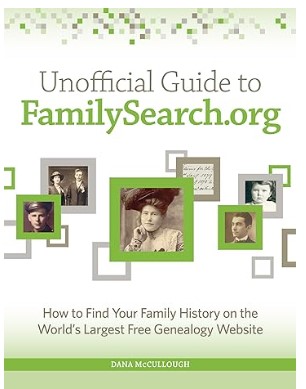
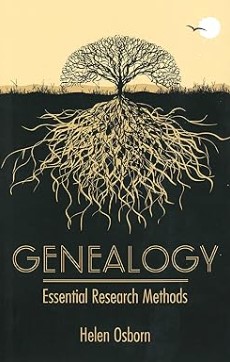

The 1901 UK census single column for deaf or dumb, blind, lunatic, imbecile or feeble-minded throws up some challenges. The subject of my research has a tick in this column and a difficult-to-decipher annotation [par?]. Any suggestions as to how I might further clarify thick tick (which appears against many entries of all ages) would be useful.
The ticks everywhere on a census return were usually made by the enumerator as he was counting people, occupations etc. I’m not sure what “par” would mean, it’s not an official abbreviation given in the Guide to Enumerators. If it’s in column 17, maybe it’s short for something like “paralysed” as that wasn’t one of the 4 numbered options. You can see the Directions to Enumerators for the 1901 census here: https://www.genuki.org.uk/big/eng/EnumInstr